The Jews call it the Shoah. The rest of the world knows it as the Holocaust. From January 30, 1933, until May 8, 1945, the Nazis systematically and institutionally murdered some six million European Jews. In the wake of the most prolific genocide in all of human history, the nation of Israel declared its independence on May 14, 1948. The surrounding Arab nations declared war the following day, determined to push the fledgling nation into the sea.
Those first few years represented a literal fight for survival. Cut off from outside support, the nation of Israel relied upon surplus arms smuggled in from European battlefields to sustain it in its fight against its belligerent Arab neighbors. In many cases, German weapons that had recently been used in an attempt to obliterate the Jewish people were taken up and turned against Israel’s enemies. Amidst this sordid milieu, it became obvious that Israel required a domestic source of arms if it hoped to prevail.
Uziel Gal was a German-born Israeli who served half of a six-year sentence after having been arrested for carrying a gun illegally in the British Mandate of Palestine. He was released in 1946, two years before Israel declared her independence. A gifted designer, Gal began work on a new submachine gun and completed his first prototype in 1950. Christened the Uzi after its designer, this rugged combat weapon first saw use by Israeli Special Forces in 1954. Two years later it became the standard issue submachine gun for the Israeli Defense Forces.
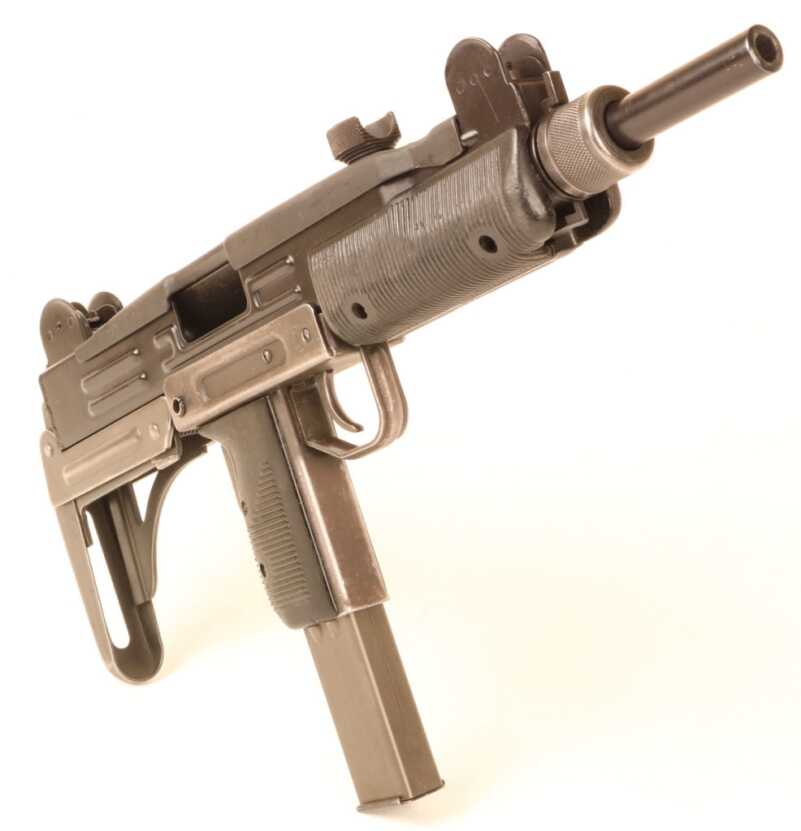
The Uzi is the most produced submachine gun in history. Used by more than ninety countries and produced around the world, the Uzi is an icon.
More than 10 million copies of the Uzi have seen service in 90 countries, making the Uzi the most produced submachine gun in history. The basic Uzi design can be had in three different chassis and several variations. The Uzi remains in production today.
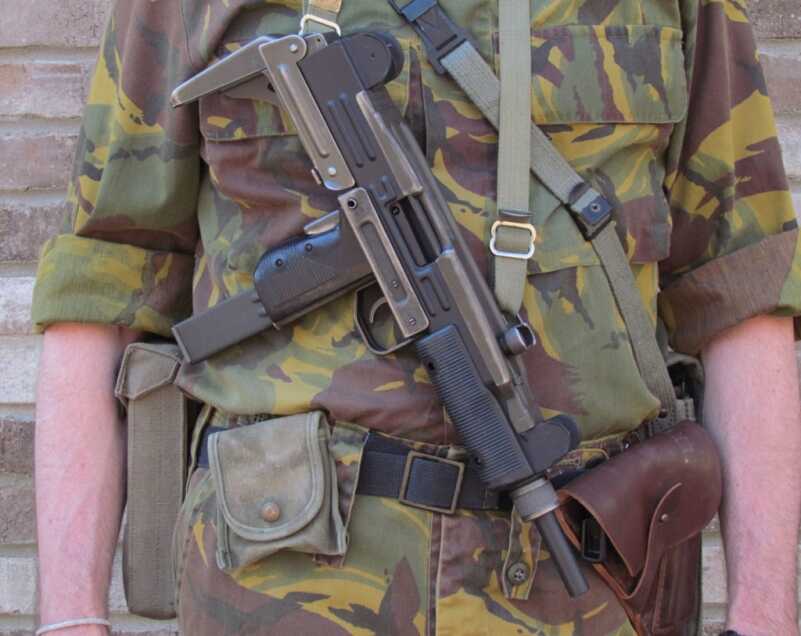
The Uzi has seen active service in brushfire wars across the globe. It is a particularly common finding in the Middle East and Africa.
Uzi Morphology
The Uzi was designed from the outset to be easily manufactured. The receiver of the weapon was formed from a heavy steel U-shaped stamping onto which accouterments like sights and trunnions were welded. The receiver sported pressed steel grooves on its interior that tended to channel battlefield grunge away from the reciprocating parts. While certain components like the bolt, barrel, and trunnion required machining, most of the Uzi could be produced quickly on industrial presses using semi-skilled labor. The Uzi also included injection-molded polymer forearm and grip panels.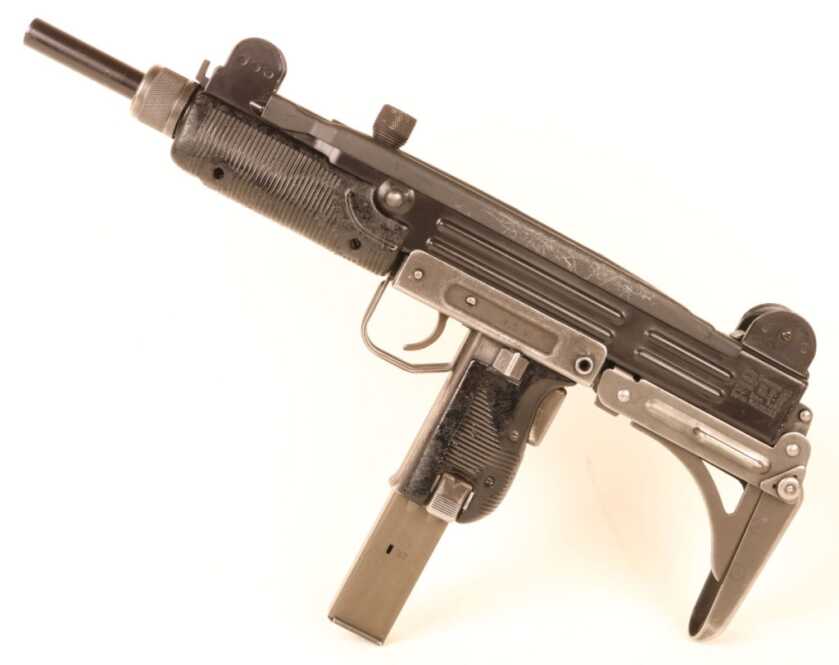
The Uzi drew its inspiration from a prototype Czech submachine gun called the ZK 476. This weapon pioneered the concept of the overhung telescoping bolt wherein the magazine feeds through the pistol grip. Acolytes of this design observe that this allows for quick magazine changes in the dark as it is a simple thing for one hand to find another.
Despite its austerity, the Uzi included a number of superb tactical amenities. Chief among them was a large and positive grip safety. This device ensured that the gun did not fire if dropped or handled roughly. There was also a ratcheting top cover that prevented the bolt from cycling unless fully retracted.
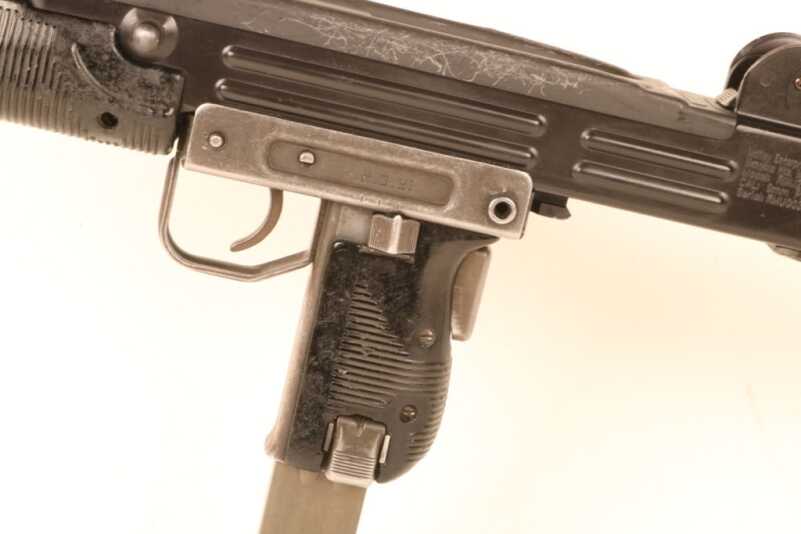
The Uzi makes extensive use of stamped steel pressings. The safety selector is a sliding switch. Backwards is safe, forwards is full, and the middle position is semiauto.
The Uzi included a rugged bayonet lug should truly close quarters combat with a bayonet be required. The folding buttstock was a complicated rotating affair that was both rigid and effective in action. The Uzi was offered with a detachable wooden stock as an option as well.
To run the gun you grip the weapon such that the grip safety is deactivated and retract the bolt via the top-mounted non-reciprocating bolt actuator. The gun fires from the open bolt so the bolt remains locked to the rear. Feed a loaded magazine into the grip until it locks. The magazine release is a left-sided paddle that is quite efficient for right-handed firers. Left-handed operators are simply screwed, but they should be used to that by now. The safety selector is a sliding switch on the left easily accessed by the right thumb when firing the gun right-handed. Pulling the trigger releases the bolt and fires the weapon.
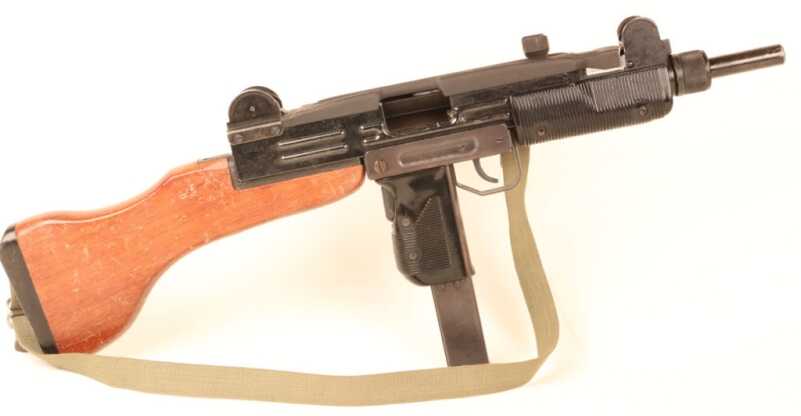
The Uzi could be had with a detachable wooden buttstock if desired. Both the fixed and folding stocks interchange without difficulty.
The MAC10—The Uzi’s Upstart American Cousin
Gordon Ingram was an American World War 2 veteran who strived to apply modern mass production techniques to the manufacture of military weapons. His Ingram Model 6 was a .45ACP submachine gun produced for Law Enforcement use in the years immediately following World War 2. While the Model 6 incorporated such advanced features as a two-position fire selector built into the trigger, the gun resembled a Thompson esoterically and could not compete in a market awash to its gunwales in war surplus submachine guns
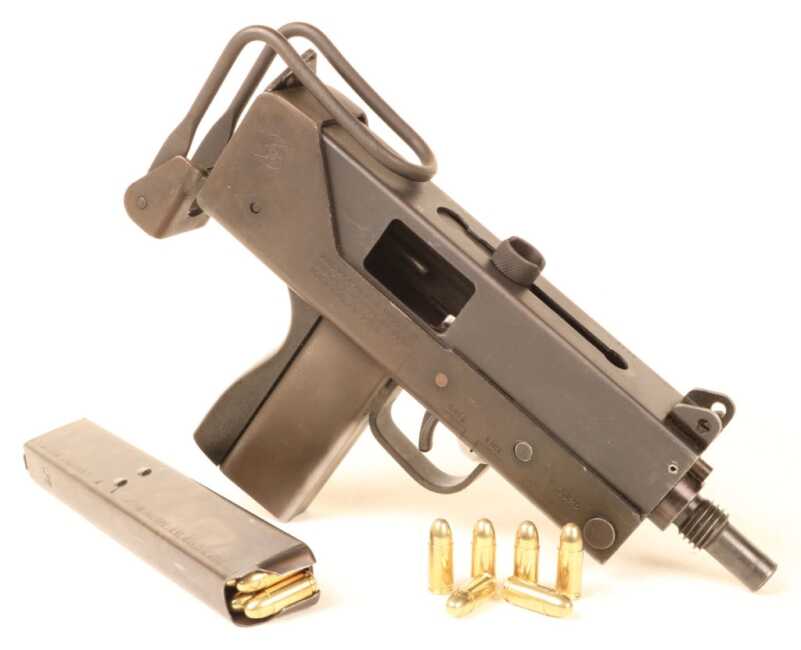
Designed in 1964, the Ingram M-10 submachine gun was intended to be as cheap and compact as possible. While indeed tiny, the M-10 was surprisingly heavy and cycled at a blistering rate.
In 1964 Ingram designed his Model 10. The M-10 was ultimately chambered for either 9mm or .45ACP and was as compact as a submachine gun could be made given the technology of the day. The M-10 employed the same overhung telescoping bolt and grip-fed magazine design as the Uzi only on a smaller scale. The M-10 took the Uzi’s manufacturability mandate to the next level, incorporating sights, sling attachment points, and a magazine housing that were all formed from stamped steel welded where necessary.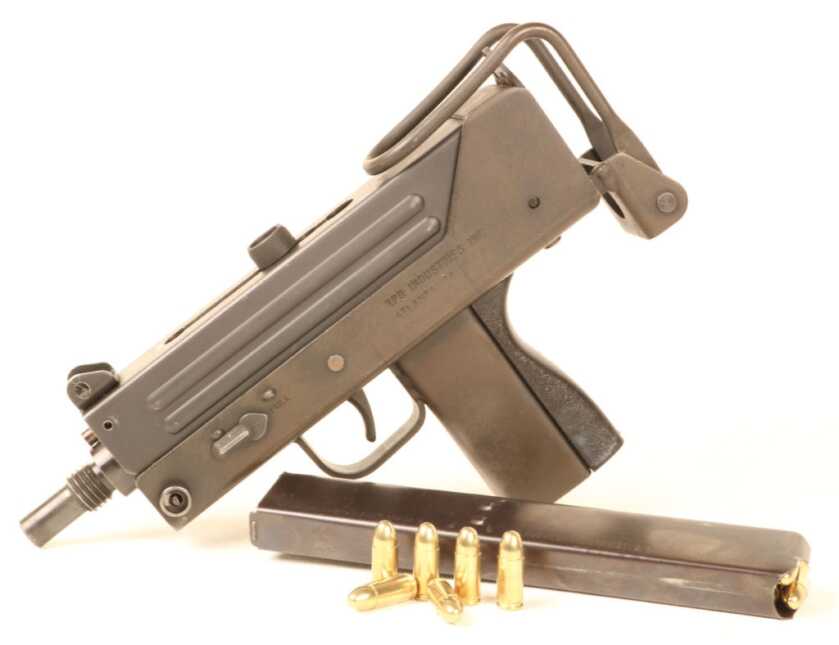
One unfortunate side effect of such a compact design was a very short bolt travel. In an open-bolt submachine gun, this meant rapid cycling on full auto and a blistering rate of fire. Particularly in its .45ACP guise, this made the gun difficult to control in inexperienced hands.
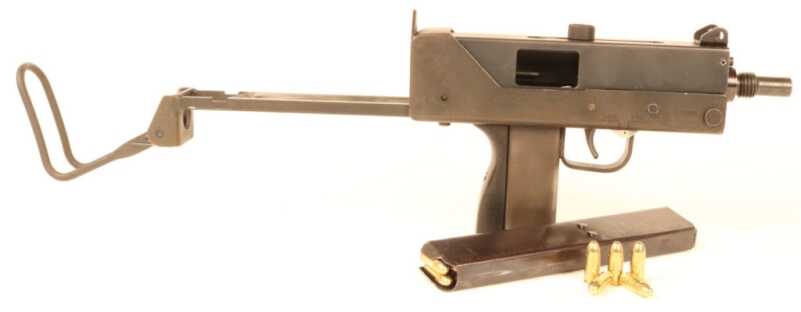
The collapsible stock on the M-10 requires a couple of maneuvers to deploy and collapse. While undeniably flimsy it is still an improvement over a conventional handgun.
In conjunction with a former OSS operative named Mitchell WerBell III, Ingram formed the Military Armament Corporation to produce and market his zippy little guns. Unique for its time, the M-10 was also designed from the outset to employ a muzzle-mounted sound suppressor. While sound suppressors are fairly commonplace today, they were radical stuff indeed in the 1970’s when the M-10 was being most aggressively marketed. As a result, their effectiveness was greatly overstated.

The M-10 was designed from the outset to operate with a detachable muzzle suppressor. This made the gun much more controllable.
The M-10 saw initial production in 1970, and unconventional warfare operatives used a very small number in Vietnam. Two years later Ingram introduced the M-11, a scaled-down version of the M-10 chambered for .380ACP and sporting an even faster rate of fire. Despite aggressively marketing the Ingram guns as a replacement for the 1911 pistol in general military service, the MAC weapons failed to secure any significant military contracts. US Navy SEALs and Special Forces, as well as the British Special Air Service, used the M-10 operationally in limited numbers. They were briefly considered as primary armament by the SAS on the Iranian Embassy raid at Princes Gate in London in 1980 only to lose out to the HK MP5. While MAC-10 has become a common moniker for the gun, the Military Armament Corporation never used this term in its marketing efforts.
One of the reasons the M-10 failed to secure extensive contracts overseas was an absurd administrative prohibition on exporting sound suppressors to foreign nations. As the sound suppressor was an integral part of the appeal of the little gun, the inability to sell the guns as a suppressed package greatly limited its marketability. While thousands of the compact little weapons were sold to American civilian enthusiasts, the M-10 ultimately died a natural death.
M-10 Details
The M-10 is as simple as a submachine gun might be. The safety is a sliding switch located in front of the trigger within the trigger guard. Its operation mimics that of the M1 Garand. The charging handle is accessed from the top of the weapon and reciprocates with the bolt. Turning the bolt handle 90 degrees locks the bolt in place for safety. The fire selector is a rotating lever mounted on the left front aspect of the gun. Pointing forwards is semiauto. Pointing backwards is rock and roll.
To fire the gun one retracts the bolt and inserts a loaded magazine into the pistol grip. The magazine release is a thumb-actuated switch on the base of the grip that is ambidextrous and easily accessed regardless of your handedness. The sights are pressed steel and rigid, but the gun bounces around so vigorously as to render them essentially worthless.
The folding wire stock on the M-10 has been much maligned and rightly so. Extending the appendage involves pinching the butt end and rotating it in place before extending the struts. In action, it is flimsy and delicate. It does, however, offer a substantial improvement over an otherwise unadorned handgun.
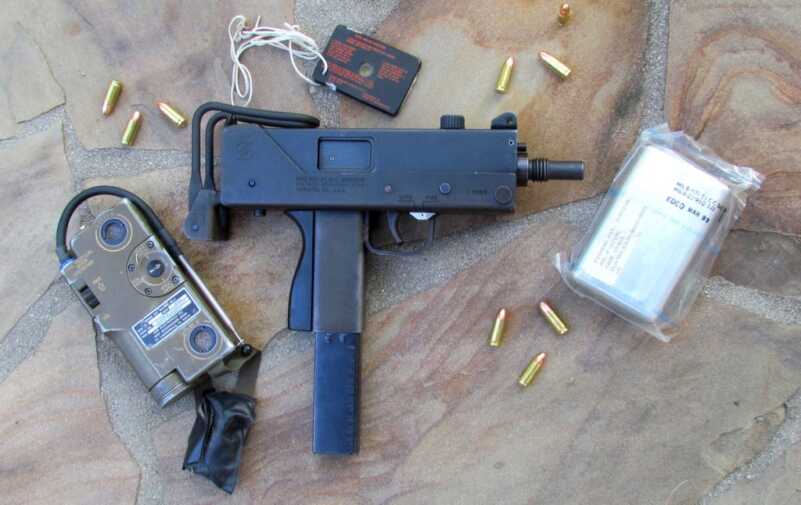
The Military Armament Corporation vigorously pursued military contracts with minimal success. While the M-10 is certainly portable, it remains difficult to control.
Comparisons
The M-10 is surprisingly heavy, weighing as much as an M16A1 rifle. The Uzi is just barely small enough to hide underneath a bulky jacket. By contrast, the M-10 will tuck into a daypack, gym bag, or briefcase without difficulty.
Given their external similarity, it was inevitable that there might arise some confusion between the weapons, particularly among the uninitiated. M-10’s, sometimes adorned with a little Hollywood window dressing, stood in for the larger Uzis in several major movies in the years before the Uzi became commonly available in the US. Stripes and The Dogs of War both featured M-10’s dressed up to resemble Uzis. However, in practical usage, these guns sport entirely different personalities.
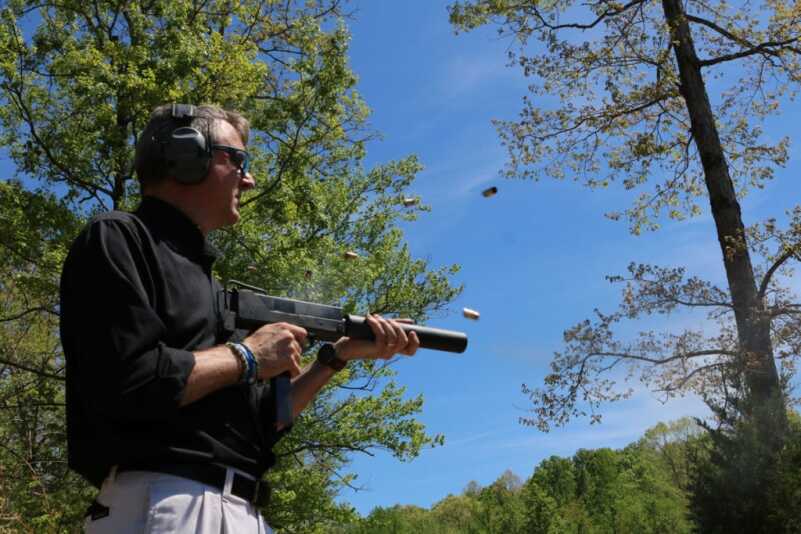
The M-10 was designed from the outset to operate with a detachable muzzle suppressor. This made the gun much more controllable.
The Uzi runs at around 600 rounds per minute. This modest rate of fire combined with the gun’s innate mass and its ample gripping space make it a thoroughly effective close quarters fighting tool. By contrast, the M-10 cycles at upwards of 1,250 rounds per minute and demands close attention to technique for safe operation. Had the M-10 been selected as the replacement for the 1911 pistol in American military service the mind boggles at the number of fingers that would have been inadvertently shot away on military firing ranges around the world. While the architecture of the guns was important, the biggest differentiator was the disparate rates of fire.
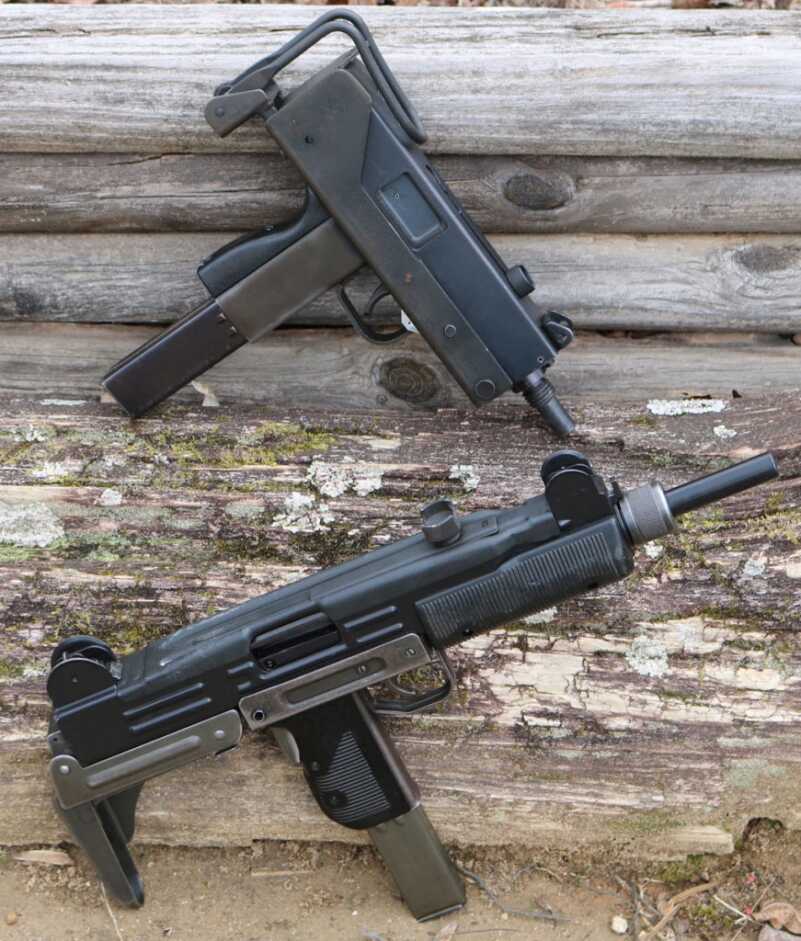
The MAC-10 and the Uzi share a great many morphological characteristics but were in reality very different guns.
The Uzi saved a nation and equipped militaries, police forces, and thugs of various stripes around the planet. It remains in production today and is an international icon. The M-10 had its moment in the sun but sputtered and died in relatively short order. Despite a niche following among American civilian shooters, it is doubtful whether the M-10 is in active service anywhere in the world today. While marketing, legislation, and export laws came into play, the primary reason one gun thrived while the other failed is that the smaller of the two just shoots too fast.
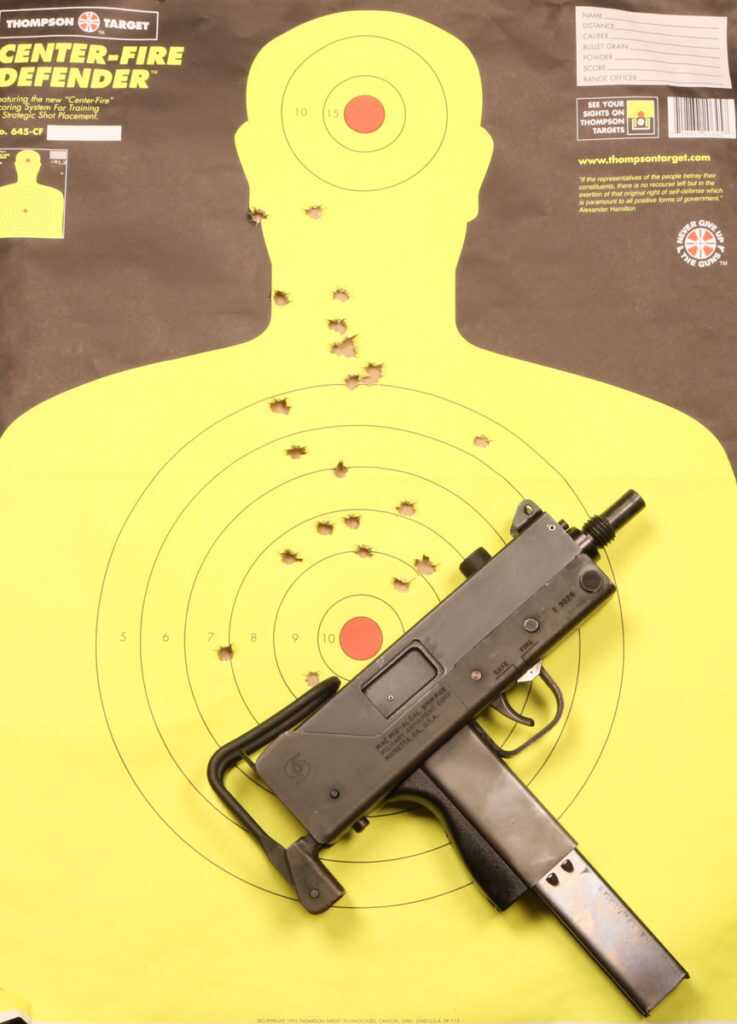
This target shows the results of 25 rounds fired in short bursts on full auto from the M-10 with the stock extended from ten meters.
Technical Specifications
Uzi M-10
Caliber 9mm Parabellum 9mm Parabellum
Weight 7.72 lb 6.26 lb
Length (Extended) 25 inches 21.6 inches
Length (Collapsed) 18.5 inches 11.6 inches
Barrel Length 10.2 inches 4.49 inches
Rate of Fire 600 rounds per minute 1,250 rounds per minute
Action Open Bolt Open Bolt
Magazine Capacity 20/25/32/40/50 32
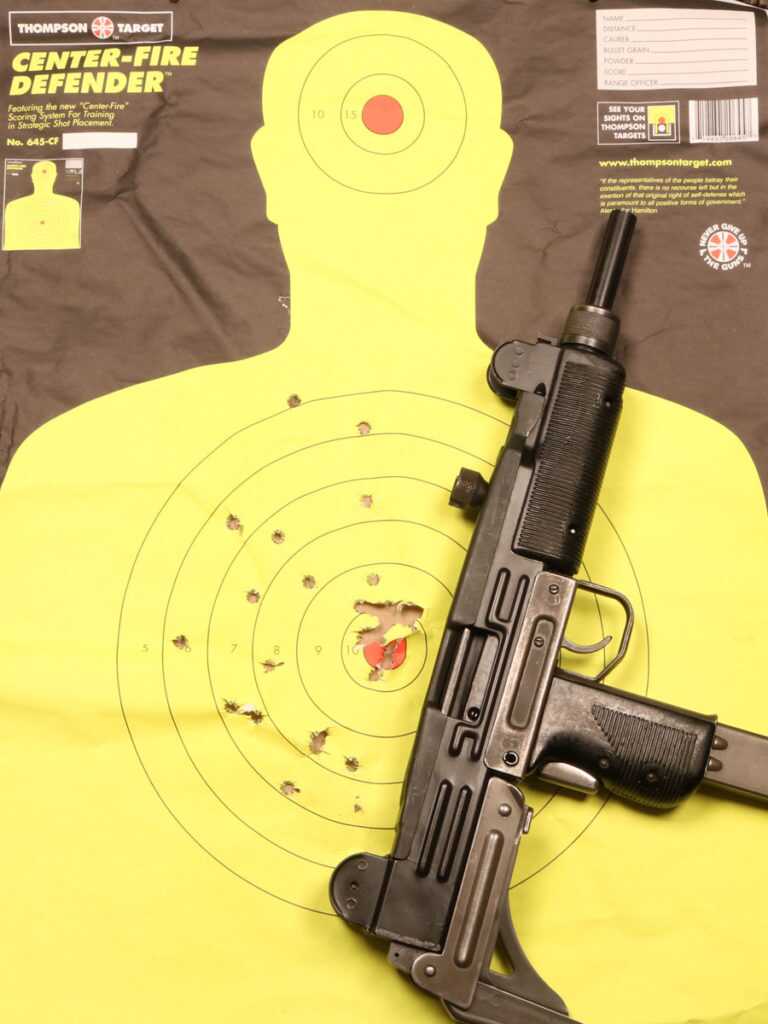
This target shows the results of 25 rounds fired in short bursts on full auto from the Uzi with the stock extended from ten meters.
***Shop GunsAmerica for your next Uzi or MAC 10***

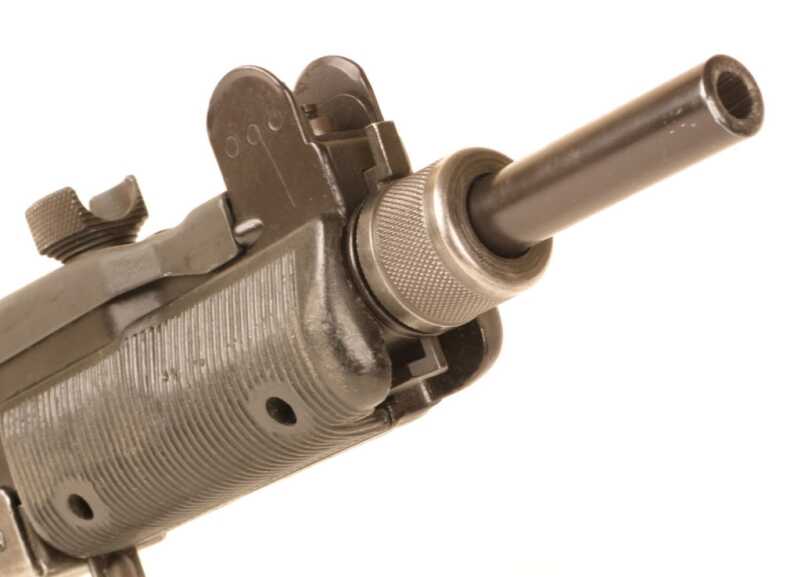
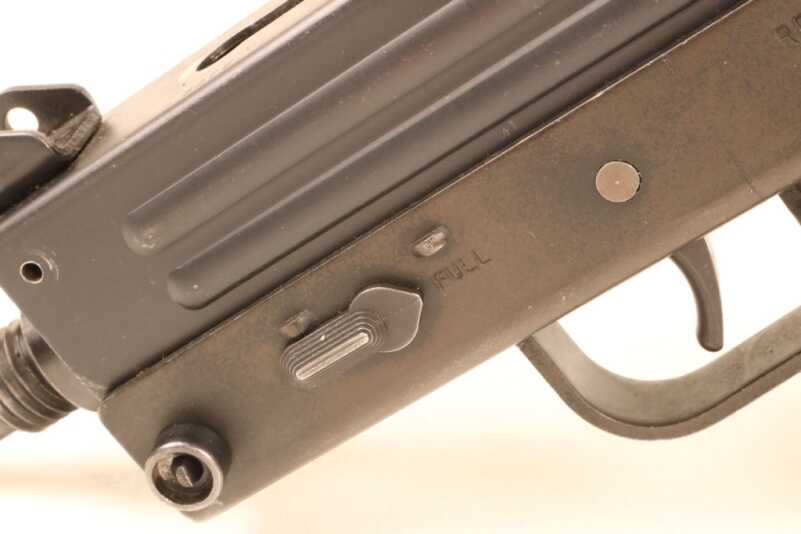
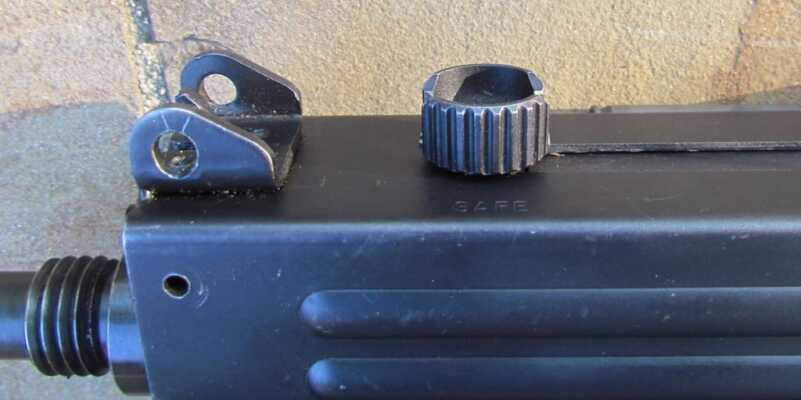
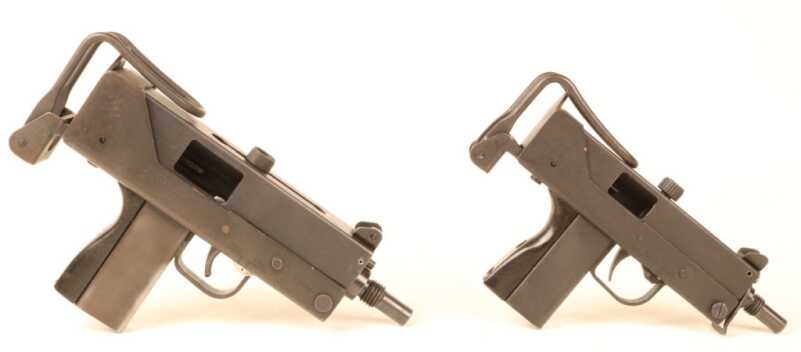

Mr. Dabbs, I noticed that none of your photos of the Ingram submachine guns show the muzzle strap, or even the washer it clipped on to, which was part of the original design. That muzzle strap was intended to be used as a foregrip, which helped keep the bullets going closer to the target and keep fingers from straying too close to the muzzle.
I enjoyed the article by Will Dabbs on comparing the full size Uzi with the MAC series of submachine guns. I wish to relate what I have learned about both of them, from past shooting experience, as well as working as a volunteer at the Head Weapons Identification Laboratory of the Israeli National Police in Jerusalem. The full size Uzi as pictured in the article, was the end design of a long evolution, from Mr. Gal’s initial design. I was a guest of IMI and Israeli Galili (of Galil rifle fame), in his R&D shop at the IMI plant in Ramat Hasheron in 1990, shortly before his death. Mr. Galili showed me a display board showing the original design of the Uzi’s top cover, which had NO ratchet safety mechanism, and several subsequent designs of top covers, before the final one was chosen. The original, like some other open bolt SMG designs, was prone to accidentally firing, if dropped, with the muzzle up, causing the bolt to move far enough to the rear, with inertia, to chamber a round and fire it, but not far enough back to be held by the sear mechanism. These and other improvements were the result of work by various members of the IMI design team, which improved Mr. Gal’s original design, as was the folding butt stock an improvement over the original wood stock.
I think a much better comparison to the MAC series with an Uzi, would have been with the Mini Uzi, which is closer to the MAC in size and cyclic rate. Having fired both, with & without suppressors, the Mini Uzi is the better design in many respects, with better ergonomics, feeding reliability, control and ignition characteristics. To be fair, the Mini Uzi is a much more recent design, taking advantage of the MAC experience. I have not fired, but have been told that the Micro Uzi, which is much closer to the size of the MAC, does not have the reliability of the Mini Uzi. As with the MAC, both the Mini and the Micro require much more experienced users. Some real tragedies have occurred when adults gave children Mini Uzis to fire. These can be uncontrollable in a beginner’s hands, or when fired by someone with little upper body strength, to control the muzzle climb, in such a light weight, high cyclic rate design. In recent years, with the advent of plastic framed pistols, liability conscious ammo companies have vastly changed the pressure peak curves, of particularly 9x19mm ammo, resulting in much ammo that will NOT reliably function a full size UZI, or many other older SMGs, designed for the older spec ammo. Yet this recent ammo WILL function both a MAC in 9x19mm and a Mini Uzi. So in that respect the MAC firing that cartridge, has a reliability advantage over the UZI, particularly with 115 gr ammo I have seen, made by Rem., Win, Fed, & S&B over the last 15 years. The Israeli military 9×19 ammo, uses the 123 gr. bullet with a sharper pressure curve, with it’s peak nearer the breech and more recoil impulse. Older Israeli military production, with convex primers, has relatively insensitive primers. So the full size Uzi has an exceptional primer strike reliability as a result. Old IMI TZ headstamp dating as far back as the 1940s, which would not function in most pistols, MACs & other SMGs due to primer deterioration, would mostly work in a full size, open bolt UZI. Some heavily modified MACs, with wooden extended butt stocks, suppressors and cyclic rate reducers, are winning SMG matches, over Uzi’s and other designs, so nearly anything can be improved over time. As for the wire butt stock & cloth strap of the original MAC designs….what were they thinking? I prefer the .380 MACs, especially with a can, as being the most practical, as in controllable, accurate and fun to shoot. John Wayne in MCQ, could not have controlled that 9×19 MAC 10, even with a suppressor, shooting it one handed out of the car window, had it fired live rounds instead of movie blanks. Thanks again to Mr. Dabbs for an interesting article and good photos.
Uzi is the most produced machine gun in history and is used extensively
This was a great article. I personally do not like open bolt sub machine guns. Dirt and gunk can get into them too easily causing malfunctions/failures to feed ammunition. The more modern Uzis have some closed bolt designs which I think are great.
In my shooting experience I got to fire the Heckler & Koch .45 Auto UMP and the Heckler & Koch MP-5 9 millimeter Luger in full automatic.
I have a semi automatic 9 millimeter Luger carbine that I love to shoot. It has twenty round magazines. I am an effective shooter with it to about 65 yards.
I actually own all three of these sub-machine guns plus an H&K MP-5 sub-machine gun and a Thompson sub-machine gun. Honestly I really love M.A.C. 11 .380 ACP sub-machine gun I can control it.
In the early 70’s I was traveling around and when I got to Israel, I found a chance to learn the Uzi. It is a simple gun that fires smoothly. While I liked it a lot, I only had 50 rounds to shoot, so my pleasure was short.
Later in the 70’s, back home in Florida, I was working at a gun store with a firing range. One of my buddies, a police officer, came running in one night, pulled me aside and showed me his new toy. It had arrived that day. We fired a few boxes of ammo after the store closed, then back to my house. He called over a few friends, and we began reloading 45 ACP till late at night. The next morning, we went to an outdoor place to shoot. We fired hundreds of rounds, picked up the brass, and were gone in half an hour. Other friends, also police, had various full auto guns. We shot them all, but my favorite was the UZI. A full auto Thompson Mod. 1927 was accurate in short bursts, but the UZI in 9 mm was as smooth as you would like your face after shaving. Anyhow, that’s my opinion. (But bear in mind, I have never liked or owned a 9 mm. In a pistol, I prefer 40 S&W or a good old 1911 in 45).
The M-11? Well sometimes there is such a thing as too fast. Ask any lady.
The M.A.C . models were M10, available in .45acp and 9mm, M11 in .380acp. The M11/9 was a later development by a different evolution of the company called RPB, and later SWD. The M12 in .380acp is a much later design, 90’s I think.
Comparing a MAC 10 or 11 to an UZI is like comparing a Vega to a Chevy. Both the MAC and the Vega were 50,000 mile/round throw-aways.
In 1983 I bought an original Military Armament Corp. M-10 in .45 acp. with a 3 digit serial #. Along with it was the suppressor, also MAC, with a 3 digit serial #. However the #’s were not the same. They were very close. It came as a package with a cool black, zip up case made specifically for holding both the firearm and the suppressor, three 35 round magazines and the suppressor disassembly tool. These were the first full auto firearm and suppressor I owned. On that day, the dealer let me shoot all three versions, .45 acp, 9mm and .380 acp. All were suppressed. The .45 acp. was truly quiet even in full auto and even with the selector in FA you could still control the number of rounds , even getting off only one round if you wanted.. The 9mm had the sonic crack as we did not have subsonic ammo. The .380…… well that was the most fun! Wow! Hellacious rate of fire. Of course I was new to full auto, but still it would dump a magazine so fast I could not react fast enough to keep it from emptying. When it came down to it, I chose the .45 acp. because it was easier to control, was truly quiet when suppressed and the ammo was common and less expensive. Expense is definitely a consideration when your firearm can dump a 35 round mag in 1.2 seconds. Just for FYI to show how different things were when I bought the M-10, I paid $650 for the M-10, suppressor, 3 magazines, tool and case. Remember this was before the 1986 ban. And you want to hear something really different from today? I had the approval back from ATF with the tax stamps for both in only 30 days!
How did you get those stocks to extend 10 meters?! 😁
“Belligerent Arab Neighbors.” Kind of tame talk for what their goals were and still are.
Almost everyone refers to the tension as the “Arab/Israeli” conflict. I feel the source of hostilities is more religious than land or ethnicity. Mohammed hated the Hebrews. I don’t know why. Perhaps because Jews were devout and refused to convert to his new religion. Anyway, I believe the only way to achieve peace in the region would be for Islamic leaders to end their nefarious goals of destroying/decimating/driving into the sea the Jewish people. Clearly the “Land For Peace” plans are not working!
It’s biblical prophecy from the book of genesis. Abraham had two sons, Isaac and Ishmael. Jews decended from Isaac and Muslims from Ishmael. Ishmael hated Isaac because he was the favored son promised by God, and Ishmael was the result of Abraham not trusting Gods promise of his decendents becoming a great nation. The bible said that because ismael hated Isaac, his “hand would always be against his brother”. To this day, that has been the case.
The review didn’t mention which of the two was the most reliable. In my opinion, the one that has the least “failures to eject, or failures to chamber and fire” is by far the best. Nothing worse than a jammed weapon.
Your models and calibers are not correct… M11-9mm, M12-.380
I believe Steve is correct. M10 is .45acp, m11 is 9mm luger and m12 is .380.
Mini uzi has very high rate of fire also.
As originally manufactured by M.A.C., the M10 was available in both 9mm Luger and .45 ACP, while the M11 only fired .380 ACP.
Clones obviously aren’t named as consistently.
Actually it’s:
M-10 (.45 caliber) : produced by Military Armament Corporation, and RPB Industries
M-10 (9mm) : produced by Military Armament Corporation, and RPB Industries
M-11 (.380 caliber) : produced by Military Armament Corporation, and RPB Industries
M-11/NINEmm : produced by SWD, Inc.
M12 : produced by SWD, Inc. (semi-auto pistol only)
Did he really say “prolific genocide”?
Very bad form, dude.